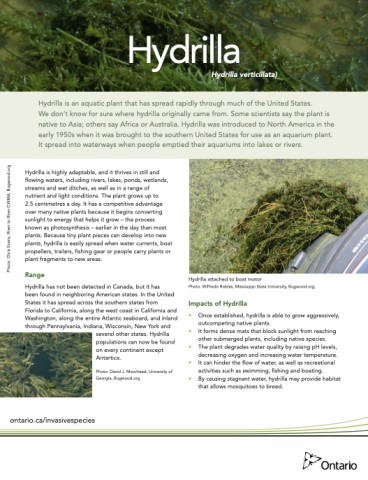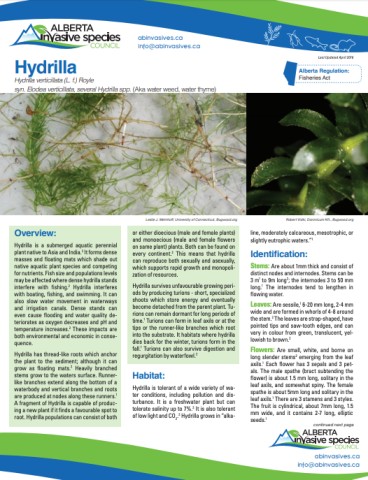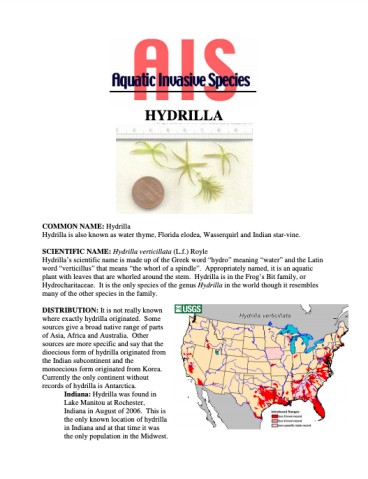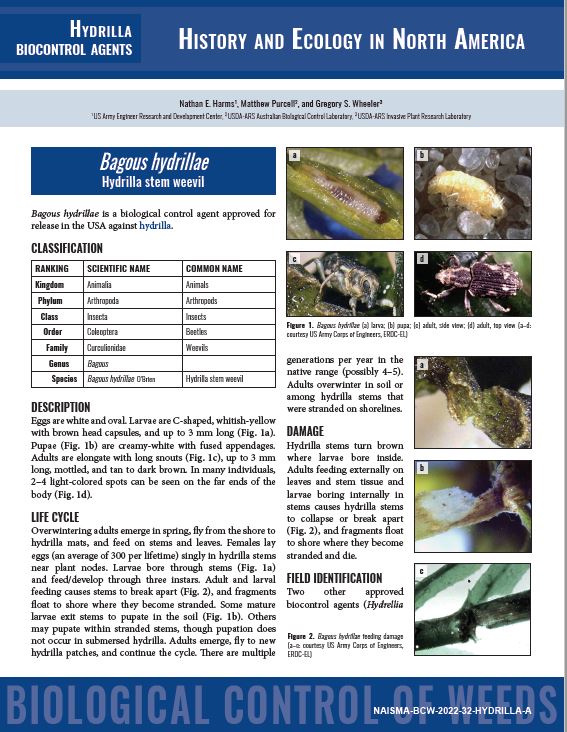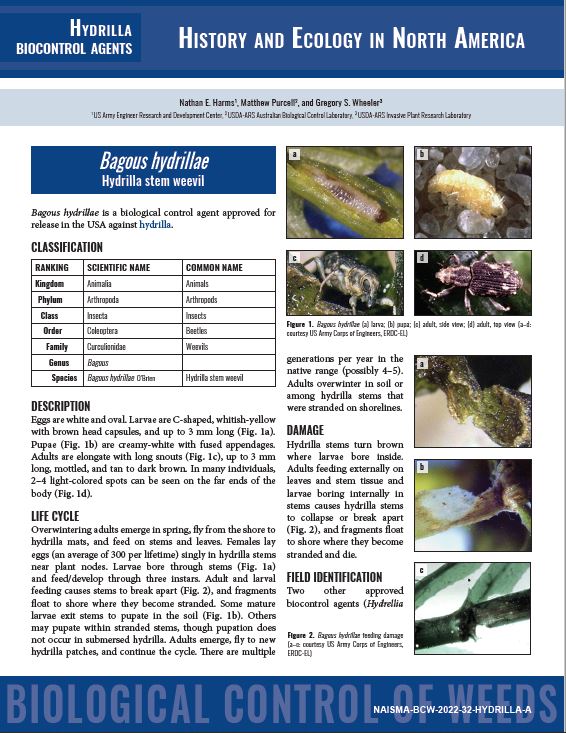Hydrilla (Hydrilla verticillata)
French common name: Hydrille
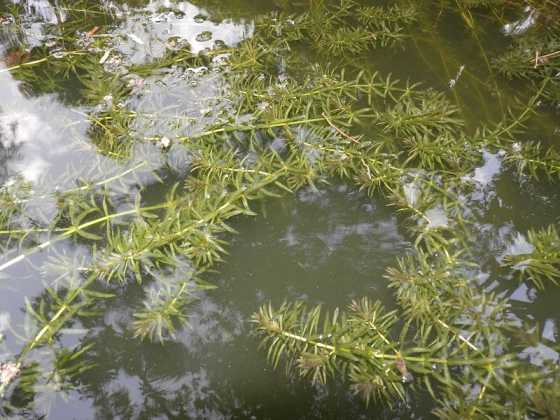
Hydrilla infestation
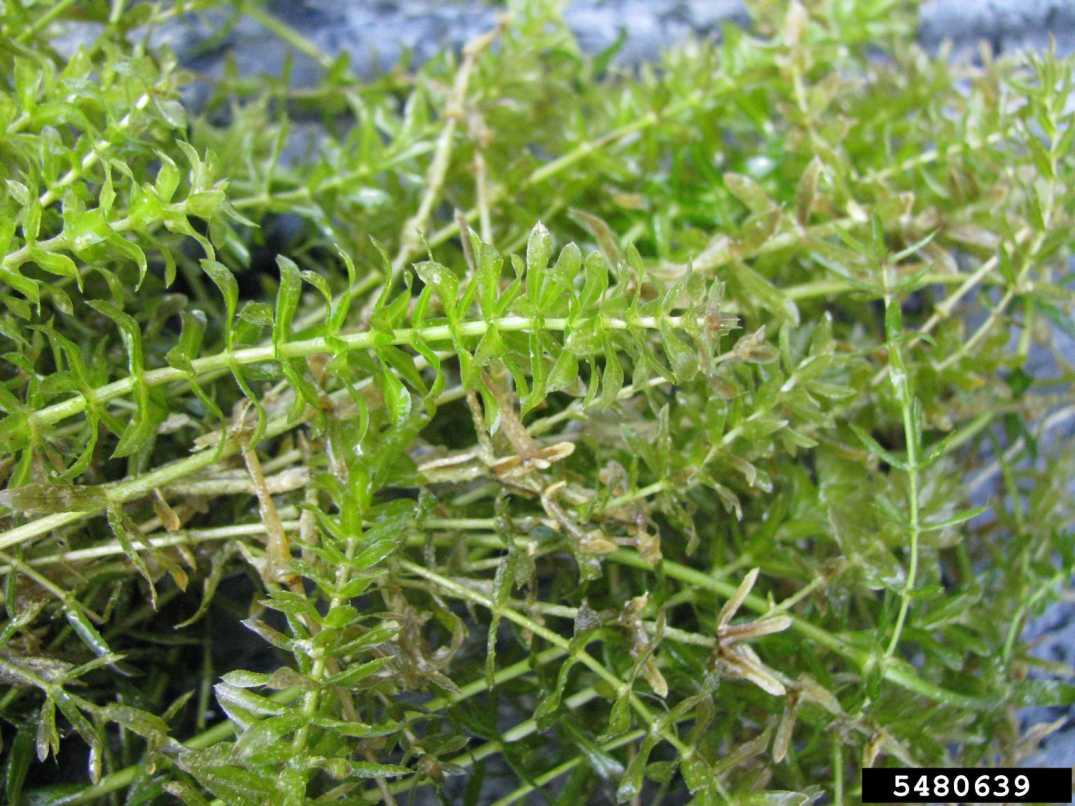
Hydrilla out of water
Photo credit: Leslie Mehrhoff
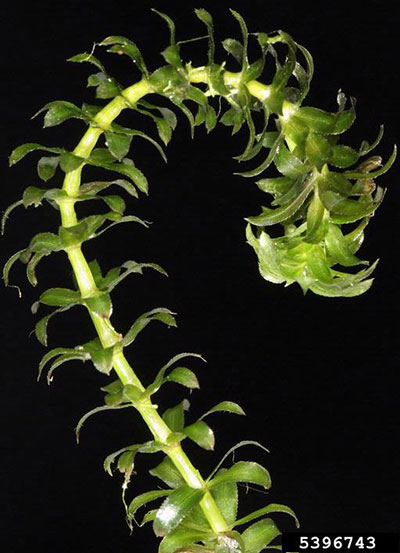
Hydrilla stems
Photo Credit: Robert Videki, Doronicum Kft., Bugwood.org
Hydrilla, has been detected for the first time in Ontario and Canada in the West Cell at Hillman Marsh Conservation Area located in Leamington, Ontario. Learn more here.
Order: Alismatales
Family: Hydrocharitaceae
Did you know? Hydrilla can be found on every continent except Antarctica.
Hydrilla grows underwater with rooted stems and reaches up to 7.5 m high, with rows of three to eight tiny (1-2 cm) green leaves arranged in circles around the stem. Roots and stems produce specialized, overwintering buds (turions). The turions formed on rhizomes are potato-like, brownish in colour with a smooth surface, while turions on the erect stems are green with scales. Hydrilla leaves have serrated edges and prickly hairs on the underside. This invasive aquatic plant can dramatically degrade water quality, causing a decrease in native species by blocking sunlight, decreasing oxygen levels, raising pH levels, and increasing water temperature. It also makes swimming, boating, and fishing very difficult and decreases water flow, which can create mosquito breeding grounds and clog irrigation pump filters.
Hydrilla is very easily spread by fragments of the plant. Always take extreme care when boating around affected areas and wash your boat and recreation equipment thoroughly after use.
Hydrilla is highly adaptable. It thrives in still and flowing waters, including rivers, lakes, ponds, wetlands, streams, and wet ditches, and can also tolerate a range of nutrient and light conditions. The plant grows up to 2.5 cm a day. It has a competitive advantage over many native plants because it begins photosynthesis (converting sunlight to energy that helps it grow) earlier in the day than most plants. Because tiny plant pieces can develop into new plants, hydrilla can easily spread when water currents, boat propellers, trailers, fishing gear, or people carry plants or plant fragments to new areas (Ontario, 2018).
Size: Stems grow up to 9 m in length; leaves are 6-20 mm long and 2-4 mm wide.
Hydrilla was detected for the first time in Canada in 2024 at Hillman Marsh Conservation Area located in Leamington, Ontario. In the United States, it has spread across the southern states from Florida to California, along the west coast in California and Washington, along the entire Atlantic seaboard, and inland through Pennsylvania, Indiana, Wisconsin, New York, and several other states. Populations can now be found on every continent except Antarctica (Ontario, 2018).

Hydrilla is an adaptive and fast-growing invasive aquatic plant that can alter habitat and negatively impact native species (Ontario, 2018):
- Once established, hydrilla is able to grow aggressively and outcompete native plants.
- It forms dense mats that block sunlight from reaching other submerged plants, including native species.
- Hydrilla degrades water quality by raising pH levels, decreasing oxygen, and increasing water temperature.
- It can hinder the flow of water and impact recreational activities such as swimming, fishing, and boating.
- Hydrilla can provide habitat that allows mosquitoes to breed by causing stagnant water.
Learn how to identify hydrilla and avoid accidentally spreading this plant with your watercraft. (Ontario, 2018)
Report sightings of hydrilla through the EDDMapS or iNaturalist websites or mobile device applications or by calling the Invading Species Hotline 1 (800) 563-7711. A good report includes an accurate location of the sighting and photos.
For aquarium enthusiasts and aquascapers:
- Avoid planting hydrilla in your aquarium or water garden. Aquarium hobbyists and water gardeners are advised to use only native or non-invasive plants and are encouraged to ask retailers for plants that are not invasive.
- Never release unwanted aquarium plants or pets. Return or donate unwanted plants to a garden centre or pet store, or put them in the garbage.
For watercraft users:
- Avoid infested areas or reduce your speed when travelling near infestations. Your propeller can break off fragments and spread the pieces to new areas. New plants can grow from small fragments of the plant.
- Inspect your boat, trailer, and equipment after each use. Remove all plants, animals, and mud before moving to a new waterbody.
For hunters:
- Switch to elliptical, bulb-shaped, or strap anchors on decoys, which avoid collecting submersed and floating aquatic plants.
- Clean. Drain. Dry. any watercraft used while hunting.
- Inspect equipment, waders/ hip-boots, and other gear and remove aquatic plants and rinse mud from them before leaving.
For anglers:
- Inspect all your fishing equipment (lures, fishing rod, nets) for any aquatic plants, and rinse any mud before leaving.
- Clean. Drain. Dry all watercraft used while fishing.
- Do not dump the contents of your bait container into or within 30 m of any body of water.
Fact Sheets
Research
Comparative Studies of Monoecious and Dioecious Hydrilla (Hydrilla verticillata) Biotypes
Competition between Hydrilla verticillata and Vallisneria americana as influenced by soil fertility
[PDF] Adaptation to low light levels by Hydrilla
Orange Lake, Florida to determine their adaptability to low light levels. These plants were
grown in controlled environment chambers at quantum flux densities varying from below the …
Competitive interactions between Hydrilla (Hydrilla verticillata) and Vallisneria (Vallisneria americana) as influenced by insect herbivory
series methods to evaluate the impact of specialized feeding by two biological control
agents, Hydrellia pakistanaeDeonier andBagous hydrillaeO’Brien, on competitive …
Prevention Techniques
Great Lakes Hydrilla Collaborative
Recommendations for Prevention, Detection, and Response
Further Reading
The Invasive Species Centre aims to connect stakeholders. The following information below link to resources that have been created by external organizations.

